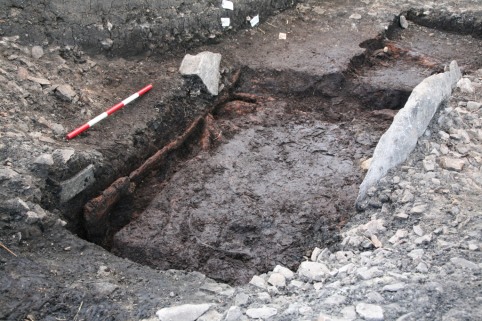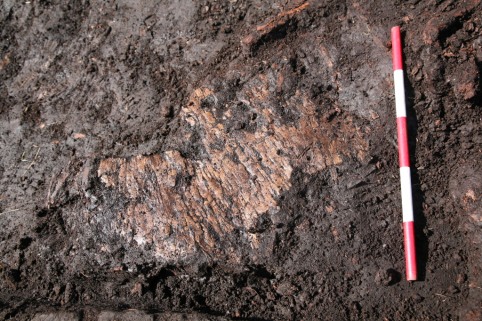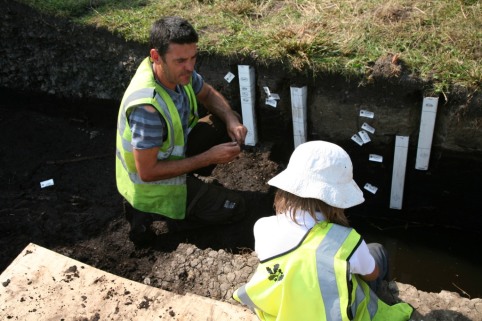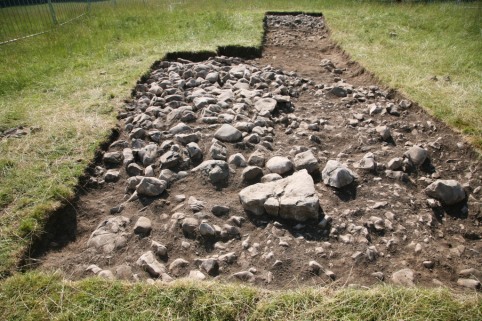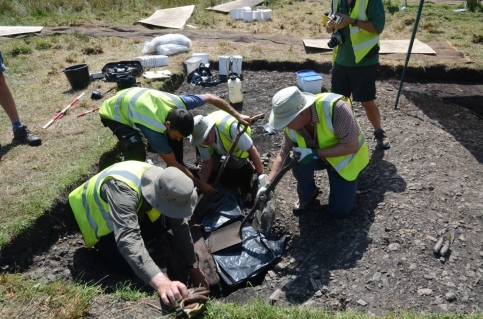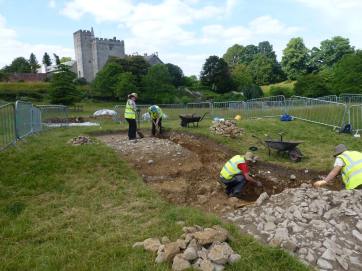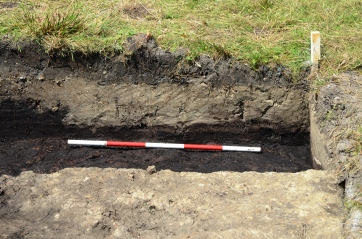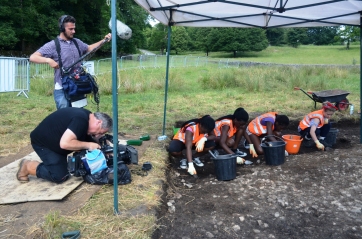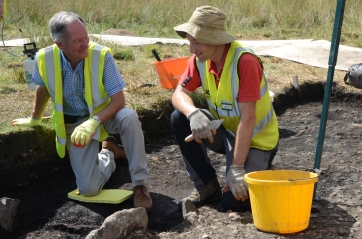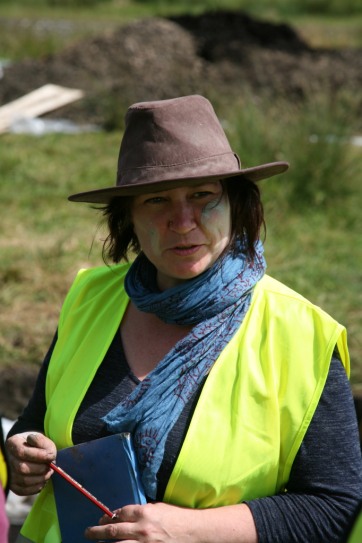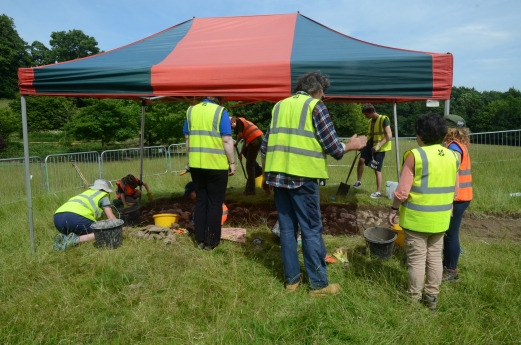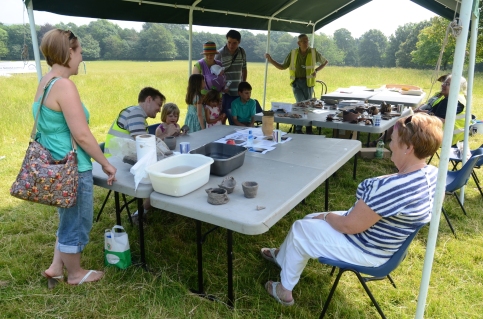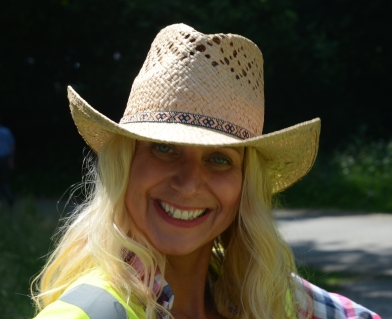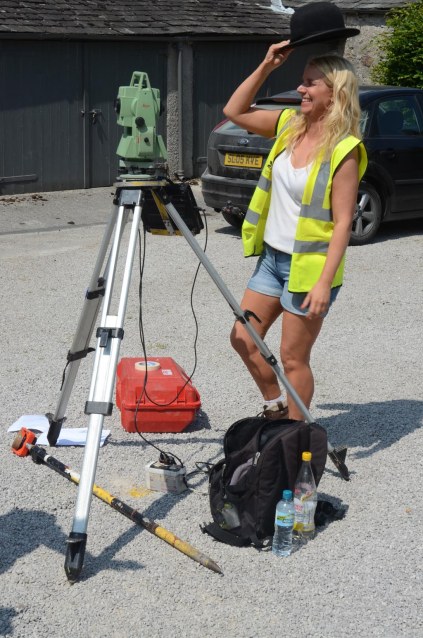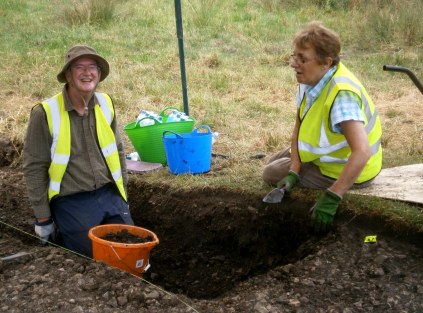Monthly Archives: July 2013
Day 16 and 17: Closing up shop
Well the final few days came on us all too fast. Sunday was a day spent cleaning a recording, via photographs, drawings, and samples, ensuring we have everything we need to complete the analysis and write the site up when we get back into the office. We also have a good turn out of members of the public, who were once again enjoying building bronze age pottery, engaging in the mini-dig, and of course chatting to the archaeologists to find out about the excavations and their results.
On Monday, the excavation and recording was complete, so the inevitable day of backfilling and re-turfing began. The Archaeologists were kindly aided by some of the volunteers and the Park Estate team and their digger in the backfilling, and after this the re-turfing dance began!
All things must come to an end, and for Sizergh, this was it, but not a complete end. When one phase finishes another one begins and, over the coming months, work will be going on behind the scenes at the OA North offices to analyse the drawings, photographs, context sheets, and samples, which make up small pieces of a jigsaw, to try to untangle the evidence we have recovered and see how much of the picture we are able to piece back together, and how many jig-saw pieces are still missing!
The blog shall continue to run on until all the work is completed, but there will no longer be daily updates as the post-excavation processes of archaeology are, by their very nature, more time-consuming. I will however be sure to add little updates to let you know how we are getting along and, let you all know when we get back any dating evidence or make any finding. By all means subscribe by email from the menu on the right hand side, it is entirely private and confidential, and you will be emailed automatically when there is a new article posted, which will save you all having to manually check the blog all the time.
We are also hoping to set up Facebook pages, twitter, and other social media site pages, as well as blogs on other projects we are involved with, so as and when we get these up and running, I will let you all know so you can keep updated by those means if you wish, and also find out what else we have been up to.
It just remains for us to thank;
The National Trust, its volunteers and staff, and the Strickland family for their help, hospitality and enthusiasm.
The staff at OAN who have worked several weeks without a break to make sure the project was a success, and brought their usual knowledge, humour, and experience to the proceedings.
The members of the public who came along who were so enthusiastic, keen to talk to us, join in the activities, learn what had been going on, and support what we were doing.
Last, but by no means least, we’d like to thank the Levens Local History Group who, as well as providing the hard efforts and enthusiasm, also made the entire project possible, and reminded a few of us professional archaeologists, just what it was that attracted us to our profession in the first place.
Many thanks to all
Adam Parsons
Day 15: All’s well that ends in the Pub
Being terribly British, we like to start with the weather! Despite being a warm sunny day, today also was a little breezier with a few patches of cloud in the afternoon, which was a welcome break, especially for those digging. We had a good turn out of visitors today, and up at the children’s activity centre had lots of budding archaeologists on the mini-dig and joining in the bronze age pottery workshop, trying their hand at building and decorating their own bronze age style pot.
Following the days work, the Levens Local History Group who have provided the volunteers, energy, and enthusiasm for the dig all came along for a final site tour. During the tour we visited all the trenches and features excavated and discussed what we have discovered, questions we still have (lots), and what happens next.

Paul Dunn explaining how the primary spoil from the ditch excavation was piled on the inside of the ditch
The teams at the top trenches have finished their excavation of the ditches, and Paul and Jamie took the opportunity to explain to us what we have discovered. The ditches are quite substantial and when they were cut the spoil appears to have been thrown to one side, forming a bank, which may suggest it is an enclosure ditch and bank, perhaps even defensive. The ditch then silted up with pretty sterile soil, with no small finds to speak of. Whilst this doesn’t necessarily rule out this being a post medieval park pale, it does rule in some other intriguing possibilities, especially as it might be reasonable to expect more bits of pottery, clay pipe and other debris, in a post medieval ditch fill. What we almost definitely, maybe, (then again perhaps not) think is, that they are not related to the deer Park.

Jamie Lund explaining the archaeology in the first of the two ditch trenches, with the later stone banks visible either side of the ditch, and on top of the fill
Though we can’t put a date to the ditch, we can suggest that it may be early… and yes this is a deliberately vague term one should come to expect from archaeologists! What we are insinuating by this term is simply that, it may be in fact be medieval, early medieval, or perhaps Iron Age, however without any scientific dating, or typological dating from finds to provide a terminus post quem, then we can’t be sure whether it is any of these or indeed post medieval as originally anticipated. What we can say for sure is that the ditch is a substantial monument, that is certainly worth further investigation in the future, and that following the ditch filling up, two stony banks were built over either side of the infilled ditch, which probably served as headlands created by the the ridge and furrow situated on either side the ditch.

Jeremy explaining some ideas about the stone platform, and demonstrating its suitability as a dance floor
The cool weather also enabled us the opportunity to remove some stones from the building platform, which revealed they were sat on an outcrop of bedrock. Jeremy explained how this is a quite unusual feature, but its size may well indicate it was the base for a quite substantial feature, perhaps agricultural, or perhaps associated with the ditch. Any resemblance to a gate house, actual or supposed, is purely coincidental.
Down at the burnt mound, yet more sampling has been undertaken; Jon has been busy taking environmental samples from every conceivable deposit (you might have waited until I had drawn the section, Jon!), and we have been recording everything in sight. In addition, an investigation of the material around the edges of the mound and some fantastic cleaning work has been undertaken by Anita, Judith, Jenny, Debbie and Bob. The wood from the trough has now been safely removed and is lying in a storage tank back at the Oxford Archaeology North premises. The removal of the soil immediately beneath the trough has revealed more roots and branches and we are trying to establish whether this is a natural phenomenon or matting thrown down on uneven roots to provide a flat surface for the trough. If the former, is it continuous with the root system in the opposite quadrant where it can be seen to be extensive? Bark is also present in this trench, so we will stand a good chance of identifying the type of tree present.
The burnt mound at Sizergh has provided an excellent opportunity to examine a well-preserved example, which consisted of a wooden lined trough surrounded by a horseshoe-shaped mound of heavily fire effected stones and charcoal. The stones were not local limestone, but stone from elsewhere, such as sandstones, which may well have been selected from local glacial erratics for their suitability in the processes conducted. The mound was built on top of a dense layer of root and branches, and was close to a source of water, and contained no small finds or evidence of bones or other materials.
So what exactly was it for you ask? Ah well… quick look over there behind you…
*runs away*
In all seriousness, we just don’t know. There are many theories on what burnt mounds are for, and the vast majority seem to involve heating water. We tend to like simple answers to questions, yet it is often difficult to give a singular answer to somethings purpose. For example; what is a hose pipe for? It can be used for watering the garden, washing the car, filling the pond, cleaning the windows, so which of these is ‘the answer‘? One might like to consider what is a sink for? Is it washing the pots? Not in this house, we have a dishwasher… yet we still have a sink! They can be used for washing our hands in them, rinsing food off, washing paint brushes in them, filling containers with water in them… in fact, I have even bathed my children in ours! So the variety of specific uses something can have can vary from person to person, place to place, and change with habit, custom, culture, preference, and of course, time.
We are pretty sure they are used for heating water, and hot water can be used for cooking, cleaning, washing, bathing, in various industrial processes, and of course boiling water helps make it safe to drink, either by itself, or as part of the brewing process. Perhaps when seeking an answer none of these should be considered to the exclusion of others. As you will have read we have many environmental samples from the mound which we will analyse over the coming months, with the hope of providing more clues to the functions of this enigmatic monument.
We gave ourselves a huge round of applause for the good work we have undertaken together, and for the organisers of this fantastic festival of archaeology. Allan Steward concluded by saying that what excited him most was picking up and connecting with an object that had last been touched by another human being 4000 years ago. Jamie Lund suggested that, at that point, connecting with a pint of bitter was what was called for, and we repaired to the Strickland Arms forthwith to the one place any civilised activity should end… the Pub!
Thanks for reading, please check back tomorrow for our final post of the excavation, and I will let you all know where we go from here!
Adam Parsons, Gill Hey, and Jeremy Bradley
Day 14: Well there’s us Stumped!
An unbelievably hot day again today, and some interesting developments from the mound. After yesterdays speculations about the roots and tree stump, today has confirmed that the mound is sitting on a tree stump and using some of the roots as part of the trough side. Could it be a special tree? There is also some fantastic preservation of the Birch Bark of the tree under the mound.
Today has also been a day of prolific sampling and recording, making sure everything is up to date before the final few days on the dig, and ensuring we have all the data, and environmental sampling we need to take away and analyse after excavation has ceased.
At the top site, the ditch trenches are almost fully excavated, though have not yet provided any evidence for its date or function. However, that of itself is still interesting, as we anticipated them being post medieval ditches relating to the parl, and full of post medieval material. Whilst this still may be the case, it has provided food for thought about what else they may be, perhaps Sizergh is holding some more secrets?
When is a building not a building? When it is excavated at Sizergh of course. The presumed building platform is, like its ditch neighbour, evading dating and diagnosis, and though we have found iron nails in it, there is little else. It also appears to be more of a stone platform or plinth, rather than stone wall footings. Hopefully, the weekend will provide us with some further clues, but with archaeology, you never really know!
On Saturday and Sunday, the children’s activities will again open up, with a mini-dig, and a bronze age pottery techniques workshop, and the Hall and Gardens are open to visitors on Sunday as usual, so why not pop down and see for yourselves and join in the fun!
Adam Parsons
Day 13: The Big Lift!
It has definitely been steamy on the burnt mound today. Jon started to lift the timbers of the wood-lined trough with help from the team. The wood is more fragile than it appeared, but large intact pieces were taken up and have been brought back to the lab for careful cleaning and analysis. We hope that we will find marks on them to tell which tools were used, in addition to identifying the type of wood and getting samples for dating.
Jacky, Barry and Stephen removed part of the burnt stone mound to look for structures underneath. One possible posthole dug by Barry may well be from animal poaching, and a stone-free patch in the mound investigated by Jacky is probably just a gap in the stones. We will persevere….
Meanwhile, on the other side of the mound, Helen and Alan continued to expose the layer of wood beneath the peat which is sealed by the burnt mound. It is now apparent that this is a root system, and Alan even exposed part of the tree stump. We are now considering whether the tree was growing just before the mound was created or was earlier in date. If the former, was it a significant tree that attracted activity, or just a handy source of wood for burning?
Gill Hey
Day 12: Schools, Ditches, and Exposed Mounds
Even more budding archaeologists took part in the Dig in the Park today. This time they came from Levens School and Crosscrake School, both near to Sizergh. They were very enthusiastic and David Maron has gone home exhausted! They did, however, make great progress in Trench 3, which contains the building. As yet we have no dating evidence, other than a few iron nails, but fingers crossed for something more conclusive in the remainder of the dig. The school groups also paid a visit the burnt mound and came up with plenty of good ideas about its purpose.
As for the mysterious ditch, well, it is still puzzling. Both ditch excavations are very close to being bottomed, and there is a continuing lack of artefacts. We are beginning to wonder if these really sterile fills suggest the ditches could be of some antiquity.
Meanwhile, I was steaming on the mound with Jon, Judith, Catherine, Frances and Sue. They cleaned the exposed part of the mound and Jon completed the trough so that he and Paul Dunn could take hundreds of photos. These will be processed in an Agisoft programme so that we can create an accurate, three-dimensional image of the trough.
We were very pleased to be joined by National Trust Head of Archaeology, Ian Barnes, who dug a big hole in the corner of the site. No, I mean he very helpfully investigated what is probably the remains of a silted up-stream which would have flowed past the north-east side of the mound. The layers are intriguing and difficult to interpret and we will take sample columns through them to analyse the soil particles in detail, as well as to examine environmental remains. The cream and chocolate colouring led to a great deal of speculation about its nearest culinary parallel.
We have also been examining a mass of timber which lies beneath the mound. Is it the root system of a tree, or are they branches and twigs. If the latter, have they fallen naturally or have they been thrown down to form a platform? Watch this space…..
Special note should be made to Ian Barnes, who showed and admirable attention to detail, trimming the grass on the edges of the trenches for photography and recording. (Edit Adam: those of us who have to deal with these images at the publication stage thing more Archaeologists should pay attention to Ian’s fine example!)
Gill Hey, Jeremy Bradley and Adam Parsons
Thanks to Stephen Read and Jeremy for the Photographs
Day 11: Updated post with additional pictures
Yesterday we had a little hiccup with the picture delivery via email, but this has all been resolved this morning so I have added a fresh batch of images to yesterdays post of the Dallam School visit, Michael Buerke and the TV crews visit, and the continuing work on the burnt mound. You can view the original post with all new images here.
Day 11: Four sides on my Trough
Tuesday was another scorcher at the Park. In other respects, however, today was different because we had some very special visitors.
Dallam School came to help us and spent all day on the Dig. After Jamie Lund and David Maron had welcomed them to the project and they had learned about what was going on and how not to injure themselves, they were able to take turns on working at four different activities. While some helped Karl Taylor with the survey of the barn, others were actually able to dig on site: at the burnt mound and, nearer to the castle, in the section through the ditch and on the possible stone building platform nearby. They all worked hard and we made excellent progress. There are some budding archaeologists there, I’ll be bound.
We were also filmed on site by RDF Television who are making a series of programmes for ITV on six National Trust properties across Britain. They are to be narrated by Michael Buerk, who was present to interview Jamie and Jeremy (I’m not bitter …. really) and who even got his trousers dirty whilst digging next to the wooden trough.
A fourth side has now been found to the wooden trough in the burnt mound and we are revealing the shallow construction trench on the outside of it. A layer of organic material containing more preserved wooden branches and debris under the mound has been investigated further, and hopefully will provide the opportunity for some good dating.
Up at the mysterious feature a few developments have been made, which we are now certain is a ditch, and that the stone banks either side are actually a later addition to the ditch itself, though quite how early the ditch is, is still a mystery. At the moment the layers within the ditch are proving fairly sterile, but fingers crossed that more will be revealed as the week progresses!
Gill Hey
(thanks once again to Stephen Read for providing photographs)
Day 10: Hats, hats and foreign hats
I thought I would just quickly add a post to show the other side of the archaeological coin; I am now working on a training excavation and survey on a Bronze Age tel in Northern Israel (a tel is an artificial mound formed by layers and layers of settlement, and defences that allows the mound to become quite high and quite large). Ours is 0.75 km long and 30m high, and is in effect a Bronze Age city. While the archaeology may be very different, what is universal is the propensity of people to wear silly hats. So here are a couple of shots of my survey team, comprising mainly american students wearing the inevitable range of head gear.

Oh yes and that is the Mediterranean in the background. Yes its a tough job but someones got to do it.
Looking over the blog and from talking to those from the site, it sounds that the work at Sizergh has been going fantastically well, and yes I am genuinely excited by whats coming up at the burnt mound. I am very sorry to not be there, and am looking forward to seeing the updated images from the burnt mound. So over to you Jeremy and Adam in anticipation.
Jamie Q
Day 9: Wood You Believe It!
… You have probably guessed it, yet another scorching hot day at Sizergh Castle, and we’ve had yet another fantastic weekend of excavation and activities!
The biggest find over the weekend has been the remains of wood lining the trough of the burnt mound. There appears to be the remains of a large plank lining the bottom, and uprights on either side, and one end. The upright stones we originally found appear to be outside the wooden box. Hopefully, further excavation will reveal more about this fascinating find!.
The team down at the burnt mound were also joined by Gill Hey and Denise Druce from Oxford Archaeology North. Denise’s expertise was called upon to take core samples of the mound and surrounding area for analysis, which can help us to build up a picture of what the landscape was like in the past, but she seemed as keen on wearing the soil as recording it!
Up at the top trenches the teams are still working away hard to uncover the date and purpose of the enigmatic feature running across the site. A few finds have been coming out, including a lead musket ball, but as yet nothing dating the feature!
The excavation team at the top site, were also joined by members of the Young Archaeologists Club, who tried their hands at excavation and recording, and also spent some time in the ‘hands on archaeology’ activity area. The activity area was manned by volunteers of the National Trust, and members of Oxford Archaeology North and included fun archaeological activities, including a kids mini dig, an artefact handling table, and a clay pottery workshop, teaching bronze age coil and strap building techniques of pottery manufacture. A great time was had here by all, learning about how finds are recovered, what they can tell us, and how they are made!
All in all, it has been a fantastic week at Sizergh, topped off by a great weekend, I certainly had a lot of fun playing with clay in the sunshine, and look forward to doing the same next weekend! For now, everyone is looking forward to next week, when we will have more local school groups being led round by David Maron of Oxford Archaeology North, hopefully we can start to answer some questions about what the enigmatic feature is, and fingers crossed for more exciting developments down at the burnt mound!
Adam P
Day 8: Hats and more Hats
Well what a day that was. Lots of activity, great weather, lots of enthusiastic volunteers and visitors, and a wooden floor to the burnt mound trough. It doesnt get much better than that. I am on my way to Israel, but before I do and while I wait my flight, here are a few more titfer photos, just to show how much you all rose up to the plate yesterday. Adam will put on a proper blog entry to cover the other aspects.
I wish everyone a fantastic day on site today and I will be looking keenly on the blog to see how the site develops.
Jamie Q







